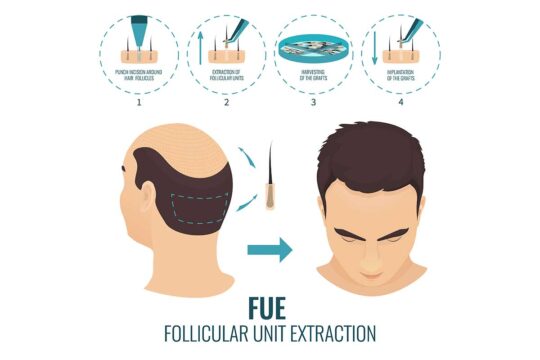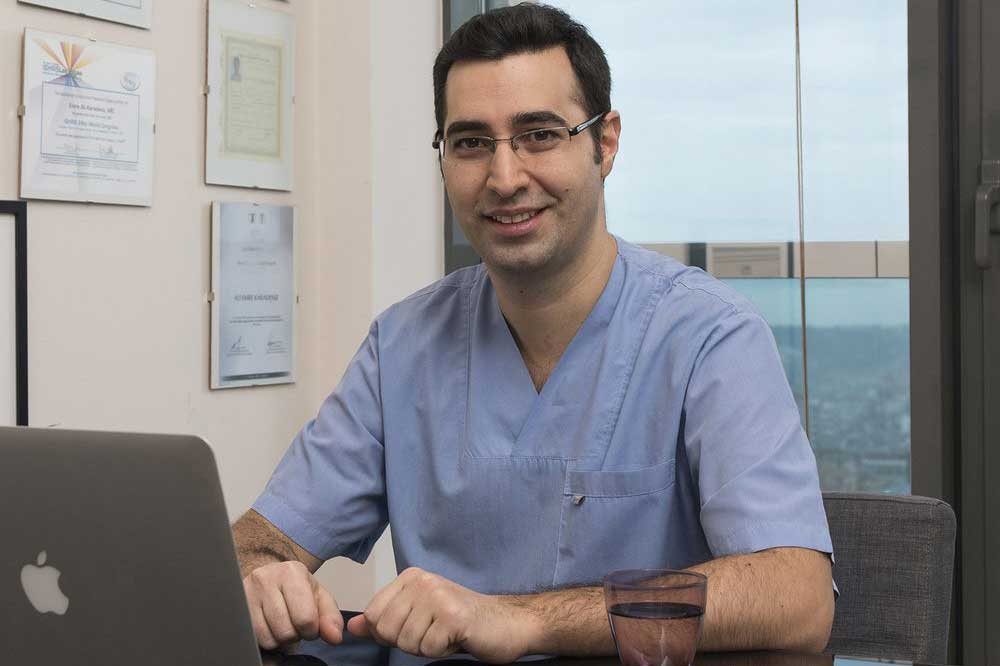
FUE Hair Transplant is the individual harvest of follicular unit grafts using a sharp metal tube called a ‘punch’.
Small punch holes are left behind at the donor area which heal on their own within a few days.
The most important determinant of the quality of FUE is the training and surgical skills of the surgical team.

The FUE technique was introduced in the hope of preventing the linear scar in FUT Hair Transplant and provide a ‘scarless’ method. However, the graft excision sites do heal leaving small scars which may be visible as either white dots or hairless spots on close examination. Although it is not true that FUE is a scarless technique, the scars can be close to invisible on a hairy scalp when performed with a good technique.
People who have hair loss problems wanted to have hair transplantation with the FUE technique when they learned that the FUE technique did not leave scars. Therefore, the FUE technique has been preferred for many years.

The main challenge when doing FUE is to prevent significant hair follicle damage by the punch, which is called the ‘follicle transection rate’, FTR.
Although FTR is widely neglected by unprofessional clinics, it is a very hot topic at scientific meetings. FTR is significantly increased when the surgeon is inexperienced; it takes a lot of practice to reduce it to an acceptable level. Dr. Karadeniz made a presentation on this topic at the 2013 Annual Scientific Meeting of The International Society of Hair Restoration Surgeons (ISHRS) in San Francisco. In unprofessional clinics the FTR can be up to 70%.

Choosing the right graft count is more than a numbers game. In scientific terms, an FUE session that safely removes about 2,000 follicular units is already considered large because each graft comes from the limited, permanent donor supply. Patients blessed with a particularly dense donor area might stretch that figure to 3,000 without jeopardizing future options. Beyond these ranges, every added punch nibbles away at the safe donor zone and increases the odds of visible thinning down the line. Clinics that casually quote eye-catching figures often bank on patients’ inability to verify whether those numbers were ever delivered.
Another very important aspect is ‘donor hair economy’.
Most clinics neglect the fact that the patient may need some donor hair to be used to fix future hair loss problems, especially in young patients.
They take advantage of the patients’ limited knowledge and desire to get the most hair at that time and quote very high graft numbers.
They not only increase their income but gain reputation as a clinic that gives more hair to their patients.
In general, hair transplantation is called the process of transplanting the hair follicles taken from the area where there is healthy hair or no hair loss, which we call the donor area, to the area where the hair is lost.
There are different methods of hair transplantation operation. These are FUT and FUE. FUT technique stands for Follicular Unit Transplantation and FUE stands for Follicular Unit Extraction.
FUE is a hair transplantation method. In this method, medical knives with micro-tips are used. With these blades, channels are opened in the scalp. In these channels, the collected hair is planted. There are two types of knives used in the FUE method. These are called sapphire and metal slit blades. Operations performed with sapphire knives are called Sapphire FUE Hair Transplantation. The knives used in FUE are updated and developed in accordance with technology every day.
Due to its geographical location, Turkey is a country that can be easily reached by people living in Asia, Europe, and the Middle East. It is a place that connects the Asian continent and the European continent, serves as a bridge between the countries and its nature is magnificent. According to the research, Turkey is a highly developed country in the field of health. Since the number of tourists coming to Turkey is quite high, this health market is also heard by other countries. Plastic surgeons living in Turkey have developed themselves a lot, especially in hair transplantation and aesthetics. The medical devices used by clinics and hospitals in Turkey also depend on today’s technology, that is, the latest model devices are used. Therefore, too many people from other countries come to Turkey to benefit from the health system.
There are many natural beauties to be seen in Turkey. It is a country famous for its history. It is one of the rare countries that is covered with seas on four sides and where four seasons are experienced every year. Therefore, people prefer Turkey for a holiday as well as hair transplantation.
Compared to America and European countries, Turkey’s currency is more suitable. In addition, hair transplantation fees in Turkey can be sold as an “all-inclusive package” from time to time. People who want to save money prefer Turkey.
Promises of these large “mega-sessions” carry hidden costs. To reach such high totals, technicians often stray outside the permanent donor band, harvesting follicles that later miniaturize and shed. Closely packed punches can create clusters of adjacent scars that merge into strip-like tracks—sometimes more conspicuous than the linear scar left by FUT. The headline number may impress at first glance, but the long-term aesthetic and medical downsides can be severe.
Yes. Some clinics market ultraminimal punch diameters as a selling point, but size must match each patient’s follicle characteristics. An internal diameter of 0.8 – 1.0 mm generally strikes the balance—lowers the follicle-transection rate (FTR) while avoiding needlessly large scars. Go too small and the punch slices through follicles more often, forcing repeated attempts that actually raise both FTR and scarring risk.
Despite marketing claims, no scientific study has shown manual punches to outperform motorized ones. What truly determines success is not the tool but the skill and integrity of the surgeon who controls it. Choose an experienced, ethically driven hair-restoration specialist who uses evidence-based techniques and monitors every parameter of the procedure.
After the hair transplantation is completed, there may be wounds and crusting in the places where the grafts are transplanted, there is no need to panic. These wounds and crusts disappear within a few days. The first 1 week after the operation is very important, go to your doctor’s controls.